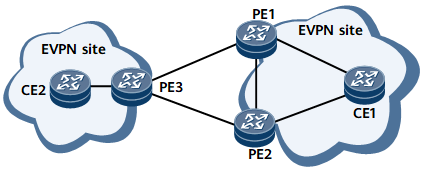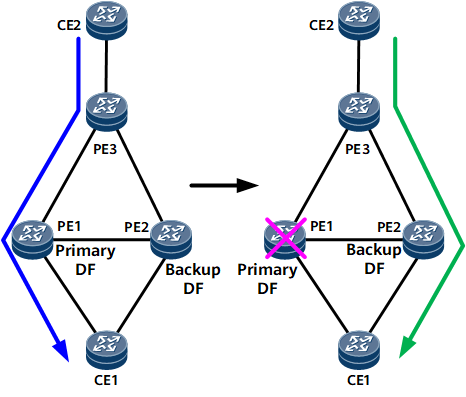Configuring EVPN Reliability Functions
This section describes how to configure Ethernet VPN (EVPN) reliability. To improve reliability for an EVPN, you can configure reliability functions.
Application Scenarios
Reliability Function Configuration |
Scenario |
|---|---|
On an EVPN where a CE is dual-homed to PEs, after a PE restarts due to a fault or other reasons, traffic may be lost. As shown in Figure 1, CE1 is dual-homed to PE1 and PE2, and PE1 is elected as the primary designated forwarder (DF). Once PE1 fails, PE2 changes to be the primary DF and takes over the broadcast, unknown unicast, and multicast (BUM) traffic. After PE1 recovers, if PE1 establishes a BGP peer relationship with PE2 before with PE3, PE1 and PE2 send Ethernet segment (ES) routes to each other. At this time, PE1 becomes the primary DF, and PE2 becomes the backup DF again. In this case, if PE3 still forwards the BUM traffic to PE2, the traffic will be discarded. However, if PE1 establishes a BGP peer relationship with PE3 before with PE2, PE1 and PE2 both become the primary DFs. In this case, PE3 forwards the BUM traffic to both PE1 and PE2, causing CE1 to receive duplicate copies of traffic. To resolve this issue, configure PE1's interface connected to CE1 to monitor the BGP EVPN peer status. This configuration allows PE1 to trigger a timer for delaying ES route advertisement once PE1 recovers and PE1's interface connected to CE1 goes up. After the delay timer is triggered, PE1 monitors the status of its BGP peers PE2 and PE3. If the BGP peer relationships both go up before the delay time elapses, PE1 sends ES routes to PE2 and PE3. If the timer-specified delay elapses, PE1 sends ES routes only to the peer with which the BGP peer relationship is up. After PE1 sends ES routes, PE1 performs DF election based on all received ES routes. NOTE:
The delay after which ES routes are sent must be set based on the BGP peer relationship status. If a BGP peer relationship is not established after the delay elapses, two primary or backup DFs exist. If two primary DFs exist, duplicate copies of traffic are sent. If two backup DFs exist, the traffic is discarded. |
|
If the PE functioning as the primary DF recovers from a fault, the traffic on the network side may be dropped due to slow connection recovery on the access side. As shown in Figure 2, at least one of PE1 and PE2 is configured to work in the single-active mode. If PE1 fails, the connection between CE1 and PE1 is interrupted, and the Ethernet segment identifier (ESI) configured for the connection to CE1 becomes invalid. As a result, PE1 becomes the backup DF, and PE2 becomes the primary DF. Traffic is switch from the path CE2 → PE3 → PE1 → CE1 to the path CE2 → PE3 → PE2 → CE1. After PE1 recovers, PE1's ESI becomes valid again, and PE1 generates ES routes immediately for DF election so that PE1 switches to be the primary DF rapidly. However, PE1 still fails to establish the connection to CE1. CE1 has to keep sending traffic to PE2, causing traffic loss. To resolve this issue, on PE1's interface connected to CE1, set a delay after which ES routes are advertised. This configuration allows PE1 to generate ES routes only after restoring the communication with the access-side network. |
|
Enable the function that the AC interface influences DF election on a PE. |
In CE dual-homing networking, an AC interface's sub-interfaces on the access side are bound to an EVPN instance. If an ESI is set on the interface and one of the sub-interfaces goes down due to a fault or some other reason, the ESI remains valid because the other sub-interfaces bound to the EVPN instance remain up. As a result, the PE does not regenerate ES routes to trigger DF election, which may prevent the BUM traffic from being forwarded. To resolve this issue, enable the function that the AC interface status influences DF election. This configuration helps check whether the PE has received the auto discovery (AD) routes from all PEs during DF election to determine whether these PEs are qualified for DF election. If a PE has not received the AD routes from a peer PE, the peer PE cannot participate in DF election. |
Set a delay for a public-network outbound interface to go up. |
In a scenario where a VLL accesses an EVPN in active-active mode, when the backup PE restarts, BUM traffic can still be forwarded due to the unstable status. As a result, extra packets are sent. To resolve this issue, configure a delay on all public network outbound interfaces of the VLL on the backup PE so that the outbound interfaces can go up only after the delay elapses. Setting a 5-minute delay for an interface to go up is recommended. |
In an EVPN active-active or single-active scenario, a CE is dual-homed to two PEs. After FRR is enabled for MAC routes on dual-homing PEs, traffic destined for a CE can be rapidly switched to the link connected to the other PE if the link between the CE and a PE fails, which ensures traffic continuity. NOTE:
The configuration described in this section applies to common EVPN and BD EVPN scenarios. For details about how to configure FRR in an EVPN VPWS scenario, see Configuring EVPN VPWS over MPLS. |
Verifying the Configuration
Run the display current-configuration command to check whether the EVPN reliability function is successfully configured.

